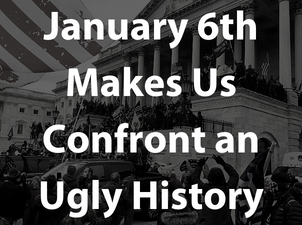
January 6 Makes Us Confront an Ugly History
Sr. Emily TeKolste, SP
January 6, 2022
One year ago, we watched in horror as the Capitol was under siege by its own citizens. A crowd composed largely of white men, many of whom were carrying weapons or symbols of violence, attacked and took over the halls of government while Congress was attempting to certify the election results. We saw symbols of white supremacy including Confederate battle flags, shirts referencing the Auschwitz Concentration Camp, and Christian religious imagery.
Make no mistake, the confluence of white supremacy, Christianity, and a violent attack on our democracy was no fluke; it was the result of hundreds of years of preparation and a continuation of a long tradition of white Christian terrorism.
During the height of slavery in the United States, white Christian leaders developed a theology to justify enslaving Black people and continued to use and develop this theology to justify white supremacy. By emphasizing personal piety and downplaying the social dimensions of the Gospel, American Christian theology has created the conditions whereby many of its practitioners don’t even see the social reality in which they live.
Despite years of involvement in right-wing political causes, right-wing Christian commentators throw accusations of politicizing Christianity at liberation theologians, practitioners of Catholic Social Justice, and anyone who wants to apply the social dimensions of the Gospel to the world in which we live. The impacts of years of intentionally tying racism to Christian theology persist among white Catholics, white mainline Protestants, and most strongly white Evangelicals, as documented by research from the Public Religion Research Institute (PRRI).
So how did we get here? The development of Myth of the Lost Cause is fascinating and troubling – a false narrative pushed by the United Daughters of the Confederacy and others into schools, churches, and public monuments. This narrative recast the Confederacy as about family and heritage instead of the reality: the Civil War was about the right of enslavers to continue enslaving Black people. While this narrative has been perpetuated in many public spaces, it’s critical that we address the ways that it has been perpetuated in American Christianity.
As Clint Smith explores in “Why Confederate Lies Live On” (published in The Atlantic), one of the ways well-documented historical falsehoods about the Civil War live on is through church buildings that honor the so-called Confederate martyrs in stained glass, including the chapel at the Blandford Cemetery in Petersburg, Virginia, that Smith highlights. In the book White Too Long, Robert P. Jones traces the explicitly Christian theological connections to the Lost Cause narrative. In fact, the whole Lost Cause narrative draws on an eschatology that proclaims the future victory of Jesus over the world. Its implication: “Just as Jesus was resurrected from the dead and will ultimately come again to rule the earth in righteousness, there will yet be a time when the noble ideals of the Confederacy, even if not the practice of chattel slavery itself, will rise again.”
This is made even more explicit by the fact that the Lost Cause has been depicted in stained glass in Christian churches across the South. Robert E. Lee, Stonewall Jackson, and Jefferson Davis were depicted as or with Jesus, the New Testament apostles, and the Old Testament patriarchs in the sacred art of stained glass windows. In the Lost Cause narrative of American Christianity, the very people leading the charge for continuing to enslave Black people and elevate white supremacy became saints, and the Confederacy became the God’s Chosen People.
Perhaps most pernicious is when these connections between Christianity and the perpetuation of white supremacy become invisible, as they have largely done through a theology focused on individual salvation and a personal relationship with Jesus. Jones points to a 2000 study by Michael Emerson and Christian Smith: “Particularly in questions related to race, they found that white evangelicals’ cultural toolkit consisted of tools that restricted their moral vision to the personal and interpersonal realms, while screening out institutional or structural issues.” If we cannot see the structural issues at play, we will never be able to address them.
It’s fascinating to me as Smith shares of the many Confederate sympathizers he talks to how much emphasis they place on “truth.” They say that they want the story told to be “truth” while denying well-documented truths about the white supremacy behind the formation of the Confederacy. In a New York Times article following the white supremacist massacre at Emanuel AME church in South Carolina, Greg Stewart, a member of the Sons of Confederate Veterans, says, “You’re asking me to agree that my great-grandparent and great-great-grandparents were monsters.”
It can be painful to grapple with the truth of our own family and personal histories, but we must do exactly that. Whether we are members of the Sons of Confederate Veterans or not, we have been raised in a culture infused with white supremacy. The institutions we love have been shaped by white supremacy. And it’s clear that our Christian and Catholic faiths and Church have been shaped by white supremacy. We must confront this if we are to correct it – to heal and move into a new day of justice, peace, and equality.
For further reading:
- How the Word Is Passed: A Reckoning with the History of Slavery across America By Clint Smith
- White Too Long: The Legacy of White Supremacy in American Christianity by Robert P. Jones
- Racial Justice and the Catholic Church by Fr. Bryan Massingale
- Divided by Faith: Evangelical Religion and the Problem of Race in America by Michael O. Emerson and Christian Smith
- White Evangelical Racism: The Politics of Morality in America by Anthea Butler







